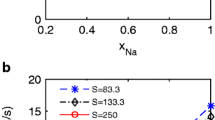Abstract
Effects of toxins III and IV (ATX III and IV) from the sea anemoneAnemonia sulcata on the Na current of crayfish giant axons were studied. Both toxins slowed the inactivation of Na channels, producing a maintained Na current during a depolarizing voltage pulse. Using the intensity of the toxin-induced maintained current as an index for the fraction of Na channels to which toxin is bound, the toxin association and dissociation kinetics were analyzed. The dissociation rate of ATX III was increased by two orders of magnitudes by depolarizing the membrane from −70 to −40mV. This increase of the dissociation rate caused a marked decrease in the binding rate of ATX III to Na channels in the same potential range. ATX IV exhibited association and dissociation kinetics that had a potential dependency quite similar to that of ATX III in spite of different ionic charge distribution in these two toxins. The results support the view that the potential-dependent kinetics of these toxins are not due to an electrostatic interaction between the ionic charges of toxins and the membrane potential but result from a modulation of the binding energy depending on the gate configuration of the Na channel.
Similar content being viewed by others
References
Béress L, Béress R, Wunderer G (1975) Isolation and characterization of three polypeptide with neurotoxic activity fromAnemonia sulcata FEBS Lett 50:311–314
Catterall WA (1977) Activation of the action potential Na+ ionophore by neurotoxins. A allosteric model. J Biol Chem 252:8669–8676
Catterall WA (1978) Sea anemone toxin and scorpion toxin share a common receptor site associated with the action potential sodium ionophore. J Biol Chem 253:7393–7396
Catterall WA (1979) Binding of scorpion toxin to receptor site associated with sodium channels in frog muscle. Correlation of voltage-dependent binding with activation. J Gen Physiol 74:357–391
Conti F, Hille B, Neumcke B, Nonner W, Stämpfli (1976) Conductance of the sodium channel in myelinated nerve fibres with modified sodium inactivation. J Physiol 262:720–742
Fujita S, Warashina A, Satake M, (1983) Binding characteristics of a sea anemone toxin fromParasicyonis actinostoloides with crayfish leg nerves. Comp Biochem Physiol 76C:25–32
Ishikawa Y, Onodera K, Takeuchi A (1979) Purification and effect of the neutotoxin from the sea anemoneParasicyonis actinostoloides. J Neurochem 33:69–73
Jacques Y, Fosset M, Lazdunski M (1978) Molecular properties of the action potential Na+ ionophore in neuroblastoma cells. J Biol Chem 253:7383–7392
Koppenhöfer E, Schmidt H (1968) Die Wirkung von Skorpiongift auf die lonenströme des Ravierschen Schnürrings. II. Unvollständige Natrium-Inaktivierung. Pflügers Arch 303:150–161
Meves H, Rubly N, Watt DD (1982) Effect of Toxins isolated from the venom of the scorpionCentruroides sculpturatus on the Na currents of the node of Ranvier. Pflügers Arch 393:56–62
Meves H, Rubly N, Watt DD (1984) Voltage-dependent effect of a scorpion toxin on sodium current inactivation. Pflügers Arch 402:24–33
Mozhayeva GN, Naumov AP, Nosyreva ED, Grishin EV (1980) Potential-dependent interaction of toxin from venom of the scorpionButhus eupeus with sodium channels in myelinated fiber. Biochim Biophys Acta 597:587–602
Narahashi T, Moore W, Shapiro BI (1969) Condylactis toxin: interaction with nerve membrane ionic conductances. Science 163:680–681
Narahashi T, Shapiro BI, Deguchi T, Scuka M, Wang CM (1972) Effects of scorpion venom on squid axon membranes. Am J Physiol 222:850–857
Okamoto H (1980) Binding of scorpion toxin to sodium channelsin vitro and its modification by β-bungarotoxin. J Physiol 290:507–520
Pelhate M, Hue B, Sattelle DB (1979) Pharmacological properties of axonal sodium channels in the cockroachPeriplaneta americana L. J Exp Biol 83:49–58
Rathmeyer W, Béress L (1976) Effect of toxins fromAnemonia sulcata (Coelenterata) on neuromuscular transmission and nerve action potentials in the crayfish (Astacus leptodactylus). J Comp Physiol 109:373–382
Romey G, Abita JP, Schweitz H, Wunderer G, Lazdunski M (1976) Sea anemone toxin: a tool to study molecular mechanism of nerve conduction and excitation-secretion coupling. Proc Natl Acad Sci USA 73:4055–4059
Schweitz H, Vincent JP, Barhanin J, Frelin C, Linden G, Hugues M, Lazdunski M (1981) Purification and pharmacological properties of eight sea anemone toxins fromAnemonia sulcata. Anthopleura xanthogrammica. Stoichactis giganteus andActinodendron plumosum. Biochemistry 20:5245–5252
Stengelin S, Hucho F (1980) Radioactive labelling to toxin I fromAnemonia sulcata and binding to crayfish nerve in vitro. Hoppe-Seyler's Z Physiol Chem 361:577–585
Vincent JP, Balerna M, Barhanin J, Fosset M, Lazdunski M (1980) Binding of sea anemone toxin to receptor sites associated with gating system of sodium channel in synaptic nerve endingin vitro. Proc Natl Acad Sci USA 77:1646–1650
Wang GK, Strichartz GR (1985) Kinetic analysis of the action ofLeiurus scorpion α-toxin on ionic current in myelinated nerve. J Gen Physiol 86:739–762
Wang GK, Strichartz GR (1986) Rapid voltage-dependent dissociation of scorpion α-toxin coupled to Na channel inactivation in amphibian myelinated nerves. J Gen Physiol 88:413–435
Warashina A (1985) Frequency-dependent effects of aconitine and veratridine on membrane currents in the crayfish giant axon. Jpn J Physiol 35:463–482
Warashina A, Fujita S (1983) Effects of sea anemone toxins on the sodium inactivation process in crayfish axons. J Gen Physiol 81:305–325
Warashina A, Fujita S, Satake M (1981) Potential-dependent effects of sea anemone toxins and scorpion venom on crayfish giant axon. Pflügers Arch 391:273–276
Warashina A, Ogura T, Fujita S (1987) Binding properties of sea anemone toxins to sodium channels in the crayfish giant axon. Comp Biochem Physiol (in press)
Author information
Authors and Affiliations
Rights and permissions
About this article
Cite this article
Warashina, A., Jiang, ZY. & Ogura, T. Potential-dependent action ofAnemonia sulcata toxins III and IV on sodium channels in crayfish giant axons. Pflugers Arch. 411, 88–93 (1988). https://doi.org/10.1007/BF00581651
Received:
Revised:
Accepted:
Issue Date:
DOI: https://doi.org/10.1007/BF00581651




